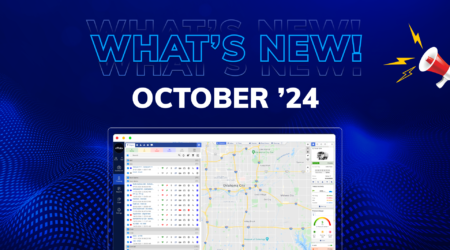The Ultimate Guide to Selecting Trucking Management Software
What is Trucking Management Software?
Trucking Management Software (TMS) is a type of software specifically designed to manage the operational activities of trucking companies. It streamlines various processes related to the movement of goods via trucks and covers a broad spectrum of functions. These include dispatching, route planning, freight billing, load optimization, order and fleet management, and compliance with shipping and safety regulations.
The software helps trucking companies increase their operational efficiency, manage logistics more effectively, ensure compliance with government regulations, and improve customer service through real-time tracking and updates. By automating these processes, Trucking Management Software reduces the burden of manual tasks, minimizes errors, and enables more accurate and faster decision-making, ultimately leading to cost savings and improved service delivery.
Why You Need Trucking Management Software
When managing a trucking business, efficiency and control over operations are crucial for success. Trucking management software (TMS) plays a pivotal role in streamlining these operations. Here’s a detailed look at why your trucking business needs a robust trucking management software:
Enhanced Operational Efficiency
One of the primary benefits of using trucking management software is the significant boost in operational efficiency it offers. TMS automates routine tasks such as dispatching, routing, and invoicing, which reduces the need for manual intervention. This automation speeds up processes, minimizes human errors, and frees up your staff to focus on more critical tasks that require human attention.
Improved Fleet Utilization and Management
Trucking management software provides comprehensive tools to manage every aspect of your fleet effectively. It helps in tracking each vehicle’s location in real-time, which is essential for route optimization and for quick redirection in response to traffic or weather conditions. Additionally, TMS can schedule regular maintenance and monitor the condition of each vehicle, ensuring that they are always in good working order, which reduces the risk of unexpected breakdowns and extends the lifespan of your fleet.
Cost Control and Reduction
By optimizing routes and loads, trucking management software helps in reducing fuel consumption and overtime costs. Efficient route planning ensures that vehicles take the shortest and least congested routes, thus saving on fuel and reducing wear and tear on vehicles. Moreover, TMS can help identify unprofitable routes or shipments, allowing managers to make informed decisions about pricing or whether to continue certain routes.
Compliance with Regulations
The trucking industry is heavily regulated, and non-compliance can result in hefty fines. Trucking management software helps ensure compliance with various regulations such as Hours of Service (HOS), the electronic logging device (ELD) mandate, and other safety regulations. It can automatically track driver hours and ensure drivers are resting in accordance with the law, which also helps in avoiding penalties for non-compliance.
Real-Time Data and Reporting
Trucking management software provides managers with real-time data on every aspect of their operations. This data includes vehicle locations, fuel usage, driver behavior, and more. The ability to generate detailed reports on these data points allows for thorough analysis of your operations, helping to identify trends, pinpoint inefficiencies, and make data-driven decisions to improve performance.
Enhanced Customer Satisfaction
Today’s customers expect fast, reliable, and transparent services. TMS enhances customer satisfaction by providing precise delivery windows and real-time updates about cargo status. This transparency helps in building trust and reliability between you and your clients, which is crucial for customer retention and acquisition.
Scalability
As your business grows, your operational needs will change. A robust trucking management software is scalable; it grows with your business, accommodating more vehicles, more routes, and more complex logistics needs without sacrificing performance. This means you won’t have to switch systems as your business expands, saving you time, money, and the hassle of transitioning to a new software system.
Key Features to Look for:
When selecting trucking management software, it’s crucial to ensure that the software has all the necessary features to streamline operations, improve efficiency, and enhance overall business performance. Here’s a detailed overview of the key features you should look for in trucking management software:
Dispatch and Scheduling
Effective dispatch and scheduling are at the heart of successful trucking operations. The right trucking management software should offer:
- Automated Dispatching: The ability to automatically assign drivers and vehicles to jobs based on location, availability, and skill set.
- Real-Time Scheduling: Updates in real-time to accommodate last-minute changes, customer requests, and unforeseen circumstances like vehicle breakdowns or traffic.
- Route Optimization: Uses GPS data to determine the most efficient routes, saving time and fuel.
Fleet Management
Robust fleet management capabilities are essential for maintaining the health and efficiency of your fleet. Look for software that includes:
- Vehicle Tracking: Real-time GPS tracking to monitor the location and movement of all vehicles in your fleet.
- Maintenance Scheduling: Automated reminders and scheduling of regular maintenance checks to prevent costly repairs and extend vehicle lifespan.
- Fuel Management: Tracking and analysis of fuel usage to identify ways to reduce fuel consumption and costs.
Compliance Management
Staying compliant with industry regulations is non-negotiable. Your trucking management software should help manage:
- Hours of Service (HOS): Ensures drivers do not exceed legal driving hours, automatically tracking and recording driver hours.
- Driver Vehicle Inspection Reports (DVIR): Facilitates the submission of daily vehicle inspection reports, crucial for safety and compliance.
- ELD Compliance: Integrates with electronic logging devices to comply with the ELD mandate, reducing the risk of non-compliance penalties.
Reporting and Analytics
Data-driven decision-making can significantly improve operational efficiency and profitability. Effective trucking management software should provide:
- Customizable Reports: Allows you to generate reports based on specific data points that are most relevant to your business needs.
- Performance Analytics: Offers insights into various aspects of your operations, such as driver performance, vehicle utilization, and route efficiency.
- Real-Time Data Access: This enables you to view and analyze data in real-time, helping you make informed decisions quickly.
Integration Capabilities
The ability to integrate with other systems and software is crucial for seamless operations. Your TMS should be compatible with:
- Accounting Software: Ensures financial data such as invoicing and payroll are synchronized with your operations.
- HR Management: Integrates with HR systems for better management of driver records, training, and certifications.
- CRM Systems: Syncs with customer relationship management systems to enhance customer service and retention.
Safety and Security Features
Ensuring the safety of your fleet and cargo is paramount. Essential safety features include:
- Driver Monitoring: Tracks driver behavior, such as speeding or harsh braking, to ensure safe driving practices.
- Cargo Security: Provides alerts and tracking to prevent cargo theft and ensure the integrity of deliveries.
- Vehicle Safety Alerts: Monitors vehicle health and sends alerts for issues like low tire pressure or engine problems, which could pose safety risks.
User-Friendliness and Support
The best trucking management software is easy to use and supported by a responsive support team:
- Intuitive Interface: User-friendly dashboard that is easy to navigate for all users, from drivers to fleet managers.
- Comprehensive Training and Documentation: Offers thorough training sessions and detailed documentation to help users understand and utilize all features.
- Customer Support: Provides reliable and accessible customer support to resolve any issues quickly.
How to Choose the Right Trucking Management Software
Choosing the right trucking management software (TMS) is crucial for optimizing your trucking operations, improving efficiency, and increasing profitability. Here’s a detailed guide on how to select the most suitable trucking management software for your business:
Understand Your Business Needs
Before you begin exploring different TMS options, it’s vital to clearly understand your business requirements. Consider the size of your fleet, the types of goods you transport, geographic coverage, and specific challenges you face. Identify the key pain points in your operations that you want the software to address, such as route optimization, fuel management, compliance issues, or customer service improvements.
Identify Must-Have Features
Based on your business needs, outline the essential features your TMS must have. This list might include:
- Dispatch and scheduling capabilities
- Real-time GPS tracking
- Compliance management for regulations like ELD, HOS, and DVIR
- Reporting and analytics tools
- Integration with other systems (e.g., accounting, HR, CRM)
- Mobile accessibility for drivers and fleet managers
Creating a checklist of required features will help you evaluate each TMS more effectively.
Research Potential Solutions
Start by compiling a list of TMS providers that offer the features and capabilities you need. You can find potential software options through:
- Industry recommendations and reviews
- Online forums and professional groups
- Trade shows and industry conferences
- Technology blogs and comparison sites
Prioritize software vendors who specialize in the trucking industry or have a strong track record with businesses similar to yours.
Evaluate Vendor Reputation and Support
Research each vendor’s reputation, focusing on customer service, support, and reliability. Consider:
- Customer reviews and testimonials
- The vendor’s stability and history in the market
- The quality of customer support, including availability, responsiveness, and resources offered (such as training and help documents)
- Updates and upgrades policy to ensure the software stays current with industry changes and technological advancements
Request Demonstrations and Trials
Once you have narrowed down your options, contact the vendors to request demos and, if available, free trials. A demo will allow you to see the software in action and assess its ease of use and functionality. If a free trial is available, use it to perform tasks that are critical to your operations. This hands-on experience can be invaluable in assessing whether the TMS fits your needs.
Consider Scalability and Flexibility
Your chosen TMS should not only meet your current needs but also grow with your business. Assess the software’s scalability and flexibility:
- Can it accommodate an increase in fleet size or operational complexity?
- Does it offer customizable features or modules that can be added as needed?
- Is it cloud-based, providing more flexibility and easier updates?
Analyze Total Cost of Ownership
Consider all costs associated with the TMS, not just the initial purchase price or subscription fees. These may include:
- Implementation costs
- Training and support expenses
- Hardware or additional software requirements
- Maintenance and upgrade fees
Evaluate the return on investment (ROI) by considering the potential savings and efficiency gains from using the TMS.
Make Your Decision
After thorough research and evaluation, choose the trucking management software that best meets your criteria in terms of features, cost, support, and scalability. Ensure that all stakeholders, including management and end-users, agree with the choice based on the demonstrations and trial use.
Plan the Implementation
Work with the vendor to plan the implementation process. This should include:
- Setting up the software
- Integrating it with other systems
- Training users
- Establishing a timeline for rollout
Effective planning will help ensure a smooth transition and quicker adoption by your team.
Conclusion
Selecting the right trucking management software is a strategic decision that can significantly affect the success of your operations. By following this guide, you can choose a system that not only meets your current needs but also scales with your business growth. Remember, the goal is to find software that makes your operations smoother and more efficient, ultimately saving time and money while enhancing service quality.
In conclusion, take your time, do thorough research, and choose a trucking management software that aligns with your business objectives and operational needs.





